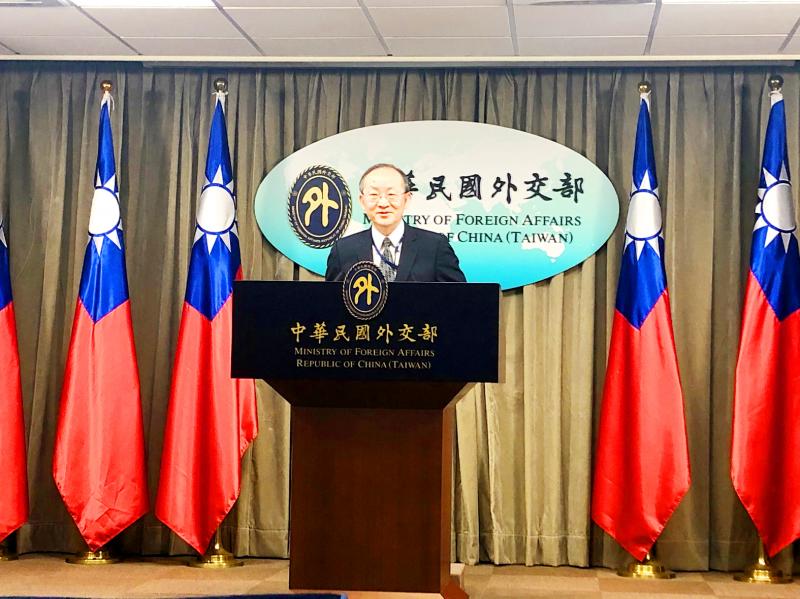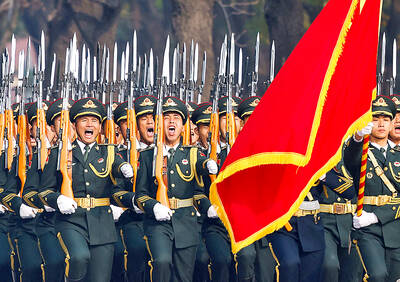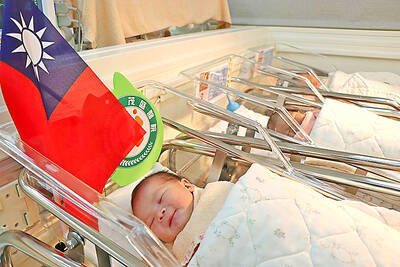Taiwan warned the WHO and China about possible human-to-human transmission of the new coronavirus at the end of last year, but the global health body did not make it public, the Ministry of Foreign Affairs said yesterday.
Department of International Organizations Director-General Bob Chen (陳龍錦) made the remark at a news briefing in Taipei, when asked about statements made by US Department of State spokeswoman Morgan Ortagus.
“Dec. 31— that’s the same day Taiwan first tried to warn WHO of human-human transmission. Chinese authorities meanwhile silenced doctors and refused to admit human-human transmission until Jan. 20, with catastrophic consequences,” Ortagus wrote on Twitter yesterday.

Photo: Lu Yi-hsuan, Taipei Times
Her tweet was in response to a post by Chinese Ministry of Foreign Affairs spokeswoman Hua Chunying (華春瑩), who wrote that the Wuhan Municipal Health Commission had issued a notice about the virus on Dec. 31 last year.
The commission’s notice reported 27 cases, including seven severe ones, in Wuhan, but said that no obvious transmission among people had been observed.
The Centers for Disease Control on Dec. 31 last year did ask China and the WHO’s International Health Regulations contact for information about the abnormal outbreak of pneumonia in Wuhan, while the ministry’s representative office in Geneva, Switzerland, also contacted the WHO secretariat, Chen said.
On the same day, the centers started implementing onboard inspections on direct flights from Wuhan landing in Taiwan, he said.
The WHO later replied that it received the message and would transfer it to other experts, but did not make it public, he said.
There are e-mail records of the communication between the centers and the WHO, he added.
Taiwan’s disease prevention strategy was predicated on the concept that the virus could be transmitted among people, ministry spokeswoman Joanne Ou (歐江安) said.
The nation thanks the US and other like-minded nations for their support, and would work with the global community to contain the virus, she said.
Meanwhile, the WHO secretariat is still evaluating whether to convene the 73rd session of the World Health Assembly from May 17 to 21, turn it into a virtual meeting or postpone it until autumn, Chen said.
Although it is almost impossible for WHO Director-General Tedros Adhanom Ghebreyesus to invite Taiwan to join the assembly as an observer, the ministry would continue to push for Taiwan’s participation in the meeting, he said.
In other developments, British Secretary of Foreign and Commonwealth Affairs Dominic Raab has advised all Britons who are usually based in the UK to return home soon, given the rapidly changing situation regarding travel restrictions and flights, the British Office Taipei said in a statement.
The advice does not apply to Britons who are residents in Taiwan.

Conflict with Taiwan could leave China with “massive economic disruption, catastrophic military losses, significant social unrest, and devastating sanctions,” a US think tank said in a report released on Monday. The German Marshall Fund released a report titled If China Attacks Taiwan: The Consequences for China of “Minor Conflict” and “Major War” Scenarios. The report details the “massive” economic, military, social and international costs to China in the event of a minor conflict or major war with Taiwan, estimating that the Chinese People’s Liberation Army (PLA) could sustain losses of more than half of its active-duty ground forces, including 100,000 troops. Understanding Chinese

The Ministry of Foreign Affairs (MOFA) yesterday said it is closely monitoring developments in Venezuela, and would continue to cooperate with democratic allies and work together for regional and global security, stability, and prosperity. The remarks came after the US on Saturday launched a series of airstrikes in Venezuela and kidnapped Venezuelan President Nicolas Maduro, who was later flown to New York along with his wife. The pair face US charges related to drug trafficking and alleged cooperation with gangs designated as terrorist organizations. Maduro has denied the allegations. The ministry said that it is closely monitoring the political and economic situation

UNRELENTING: China attempted cyberattacks on Taiwan’s critical infrastructure 2.63 million times per day last year, up from 1.23 million in 2023, the NSB said China’s cyberarmy has long engaged in cyberattacks against Taiwan’s critical infrastructure, employing diverse and evolving tactics, the National Security Bureau (NSB) said yesterday, adding that cyberattacks on critical energy infrastructure last year increased 10-fold compared with the previous year. The NSB yesterday released a report titled Analysis on China’s Cyber Threats to Taiwan’s Critical Infrastructure in 2025, outlining the number of cyberattacks, major tactics and hacker groups. Taiwan’s national intelligence community identified a large number of cybersecurity incidents last year, the bureau said in a statement. China’s cyberarmy last year launched an average of 2.63 million intrusion attempts per day targeting Taiwan’s critical

AGING: As of last month, people aged 65 or older accounted for 20.06 percent of the total population and the number of couples who got married fell by 18,685 from 2024 Taiwan has surpassed South Korea as the country least willing to have children, with an annual crude birthrate of 4.62 per 1,000 people, Ministry of the Interior data showed yesterday. The nation was previously ranked the second-lowest country in terms of total fertility rate, or the average number of children a woman has in her lifetime. However, South Korea’s fertility rate began to recover from 2023, with total fertility rate rising from 0.72 and estimated to reach 0.82 to 0.85 by last year, and the crude birthrate projected at 6.7 per 1,000 people. Japan’s crude birthrate was projected to fall below six,